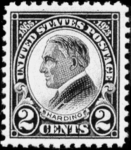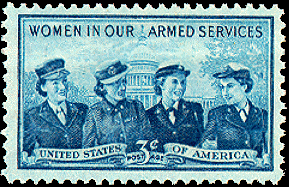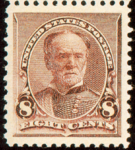A United States Bucket List
By John M. Hotchner
 Not so long ago bucket lists burst on the scene. If your nose was in your albums and you missed it, the idea was put forward that all of us approaching the September of our lives should make a list of those things we wished to do or see before December 31st of our lives.
Not so long ago bucket lists burst on the scene. If your nose was in your albums and you missed it, the idea was put forward that all of us approaching the September of our lives should make a list of those things we wished to do or see before December 31st of our lives.
Well, here I am at about October 25, and as a charter member of the procrastinators’ club, I’m just getting to this task. I’ve recently done such a list with a worldwide perspective, and found it interesting to put a laser-like focus on what I really want to get done. A friend who saw it suggested that I ought to narrow the scope to U.S. philately only, and provide it here as a means of encouraging our U.S. collector community members to do their own lists.
The size of the list is an issue. Some are satisfied with ten items. It is said that too many disappointments are the result of too many expectations, but I’ll chance it. Thus, my list presented here is 20 items; which actually works out to one a year until I’m 93. That seems do-able, if maybe a tad ambitious.
But the point is not so much to get it all done as to help the mind to have a sense of what is really important versus what is passing fancy. This can be useful for resource allocation–what will we spend both time and money on–and for sense of satisfaction as items are crossed off.
Given that no one wants to reach the end of the list and have nothing to live for, so to speak, my method will be to add something to the list every time I cross something off. It is important to have a challenge to get up for every morning!
This is a highly individual exercise. Which is a way of saying that my list won’t work for you. But perhaps it will serve as a guide on the sorts of things that you want to consider for your own list. So, even those of you who are at March 1st of your lives, I hope you will do this exercise. Dream big!
Here is my effort:
 1. Find a U.S. Scott #613, the rotary press-printed 2¢ Black Harding, perf 11. There are about 65 examples known, and I believe there are more waiting to be discovered. Since buying one is out of the question (Cat. Value: $40,000), I measure every 2¢ Harding I come across. Maybe lightening will strike!
1. Find a U.S. Scott #613, the rotary press-printed 2¢ Black Harding, perf 11. There are about 65 examples known, and I believe there are more waiting to be discovered. Since buying one is out of the question (Cat. Value: $40,000), I measure every 2¢ Harding I come across. Maybe lightening will strike!
2. Get up enough courage to start collecting U.S. revenues. I have a set of Scott album pages, but the project looks daunting. Yet much of it is affordable, and interesting, and I want to get started, but just have not been able to nd the time–or make the time.
 3. Solve the mystery of the 3¢ Servicewomen commemorative of 1952, Scott #1013, which features four servicewomen as portrayed by professional models. I know the name of one. Who are the others? Research in the les of the USPS, Bureau of Engraving and Printing, and Defense Department have failed to bring the names to light. Someone must know.?
3. Solve the mystery of the 3¢ Servicewomen commemorative of 1952, Scott #1013, which features four servicewomen as portrayed by professional models. I know the name of one. Who are the others? Research in the les of the USPS, Bureau of Engraving and Printing, and Defense Department have failed to bring the names to light. Someone must know.?
4. My hoard of Korean War postal history awaits. I bought a first class exhibit several years ago, and have my own material gathered over 30 years to add to it; and continue to find new covers. The task now is to recast and improve the exhibit.
5. My U.S. clipping files have as much unfiled material as what is in the folders. This is a  project that needs some serious work.
project that needs some serious work.
6. Get used copies of the USIR-watermarked 8¢ Sherman (Scott #272a) and $1 Prexie (#832b) for my collection.
7. Do or update at least one one-frame exhibit a year: Pending are #C22 international uses, C32 international uses, methods of marking repaired and rejected material in the Bureau of Engraving and Printing, and The Naked Maja in U.S. philately. (Readers may notice a theme here: there is an awful lot of exhibiting going on, but it has become over the years one of my favorite creative outlets, and I can’t get enough of it!)
8. Update my 1934 and 1935 Christmas seal multi-frame exhibits.
9. Encourage those who can make it happen to get a U.S. philatelic periodical on U.S. newsstands. I’m convinced that this could make a real difference in bringing 30-somethings and beyond into the hobby.
10. Give a presentation on U.S. Error, Freak and Oddity Collecting at the Royal Philatelic Society, London.
11. Reread the George Brett book on Giori Printing; the best exposition of a complex subject that marked a turning point (in the mid-1950s) in U.S. stamp production; enabling multicolor printing, and bringing life to what had been almost entirely a monocolor stamp program.
12. Convince Scott Catalogue editors to include the Allied Military Government issues from Austria, France, Germany and Italy in the U.S. Specialized Catalogue; not to mention the Korean issues. Scott includes Ryukyus, but that is only a good start.
13. Organize a 40-year accumulation of Washington-Franklin (3rd Bureau Issue) local precancels, and while I’m at it, try to discover a Scott #544, the 1¢ Rotary Press sheet waste stamp; often seen precancelled.
14. Do a booklet or book on the 60+ instances where living people are shown on U.S. stamps. This has been one focus of my Linn’s reporting over the years, and there are many interesting stories to be told.
15. Find for my mourning covers collection, a cover to or from a funeral home that was sent to a dead letter office (preferably in Deadwood, South Dakota).
16. Make sense, and maybe an exhibit, of a 50-year accumulation of U.S. postal cards with printed messages on the back that show the everyday and often munda ne activities of Americans in the late 19th and early 20th centuries; from birth to death.
ne activities of Americans in the late 19th and early 20th centuries; from birth to death.
17. Judging at the next U.S. international: 2026 in Boston!
18. Write an article on U.S. postal counterfeits each year for the book-length Fakes Forgeries Experts, produced under the auspices of the International Association of Philatelic Experts (AIEP).
19. Spend some time every day, washing, organizing, cataloguing, and putting stamps in my albums. It is surprising how easy it is for that set of activities to take last place.
20. Be around, at age 97, to celebrate and ponder the glorious 200th anniversary of postage stamps in the year 2040, and maybe even the equally glorious 200th anniversary of U.S. postage stamp general issues in 2047. Medical science is making great strides in extending life!
Fulfilling some of the entries in this list will depend upon luck (rather than bucks), medical practitioners, help from friends, will power, and the grace of God. But hopefully in 20 years or so, I can look back and say I’ve crossed at least half off the list. Now, get started on your list!
Should you wish to comment on this column, or have questions or ideas you would like to have explored in a future column, please write to John Hotchner, VSC Contributor, P.O. Box 1125, Falls Church, VA 22041-0125, or email, putting “VSC” in the subject line.
Or comment right here.




You made me think and smile..
Whenever I stop in at Barnes and Noble I usually look for a Philatelic magazine – thinking that maybe there might be something – but alas! So your #9 would be an excellent try!
And #16 is a great idea! I love reading the messages (and the use of the English language) on cards I collect!
WELL – GOOD LUCK!!!
Well now, I hope you’re immortal! I don’t want to live without a list of things I am working on accomplishing. I’m working on one item right now. I’m trying to find postally used examples of all of the modern mass produced counterfeit U.S. stamps. I found the second Vintage Rose counterfeit (see Linn’s Stamp News). That was the inspiration. I haven’t been able to find a complete list of the 40 or so known counterfeited stamps and if others have more than one major variation. I know it’s time for me to buy a new Scott Catalog. In the meantime I would appreciate it if someone, like you, could post a list. Good luck with your bucket list!
I think I have a 613.Email me and I will send pic.I’ve just come across this stamp as I was valuing an old album I inherited some 20 yrs. ago.
Hello John,
My wife and I are interviewing people who have an interesting relationship with or story around the US flag. I thought your stsmp collection was an interesting take in the subject. My name is Rollin Rachele. Email Rollin@abundantsun.com. Please let me know if this is something you would like to be interviewed about.
Hello John,
Maybe, I have a double scott 544?
I think I may have a 613 Harding Mourning 2 cent stamp. Who could authenticate it for me. There is offset marking on the back and the stamp is poorly centered.
I am in South Carolina.